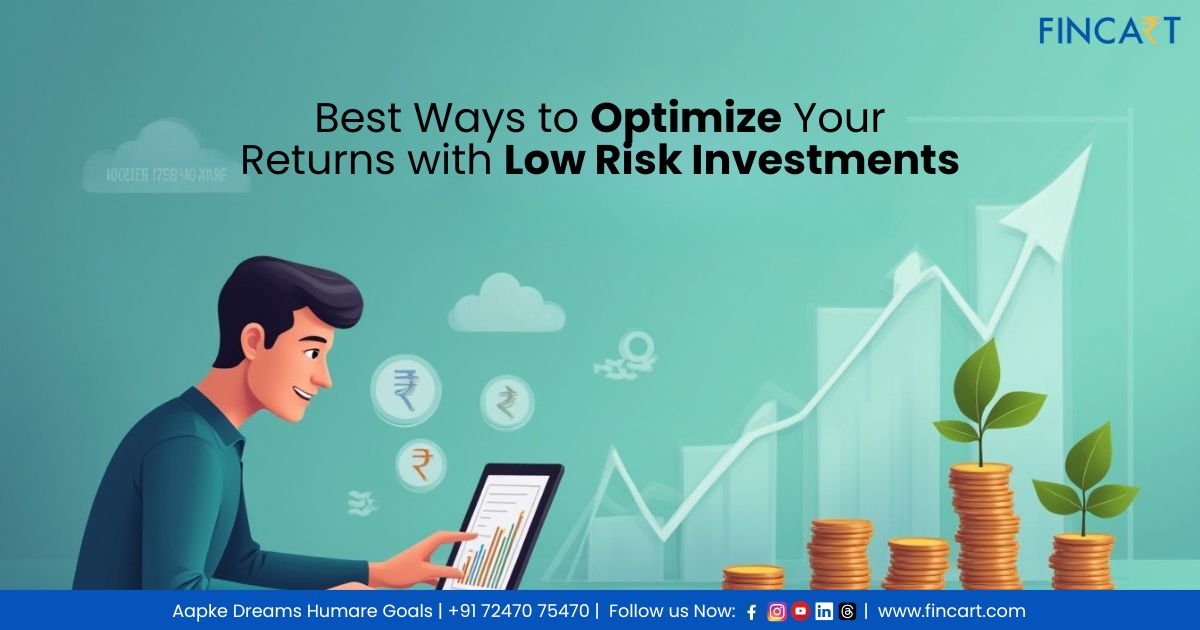Many people hesitate to invest in the stock market because they simply don’t want to lose their hard-earned money. Still, most of us want our money to do some work rather than just sit idle in a bank account. So, what can investors do if they prioritise capital protection over capital growth? Thankfully, there are plenty of Low Risk Investments that not only help you keep your principal safe but also earn decent returns and offer tax benefits. Here, we’ll look into these safe investment options and see how conservative investors can get the most out of them.
What Are Low Risk Investments?
Many different kinds of risks can affect an investment, such as market risk, interest rate risk, and credit risk. When we talk about Low Risk Investments, we’re referring to products that prioritise the safety of capital over delivering high returns. Often, these investments come with guaranteed returns, such as fixed deposits. Some low-risk options, like short-term debt funds, are market-linked, so even though the risk to capital remains minimal, their returns can vary slightly with market movements. Meanwhile, some investments, like bonds, offer fixed interest income, but their market value can fluctuate depending on prevailing interest rates. This is a concern only if you decide to sell the bond before maturity.
Low Risk Investments are mainly sought after by conservative investors looking to preserve their wealth, investors seeking a regular income, and those wanting to achieve short-term financial goals within three years.
Top Low Risk Investments
Without further ado, let’s check out some of the best Low Risk Investments available to Indian investors:
1. Fixed Deposits
When you hear the words ‘safe investment’, chances are the first thing that pops to mind is an FD. It’s for good reasons that FDs have been one of the most trusted investment choices for investors for generations. You get assured returns, the flexibility to choose a tenure that suits your needs, complete capital protection with minimal risk, and the convenience of easy access whenever you need your funds.
There are a few things to consider when choosing FDs:
- Most FDs have a fixed tenure, and withdrawing before maturity can attract penalties.
- Banks are not the only institutions that offer FDs, however, they are considered the safest source. Some NBFCs offer higher interest rates than banks, but they come with slightly higher risk, so always check the credit rating before investing.
- Senior citizen FDs offer slightly higher interest rates to individuals aged 60 years and above.
- If you’re also looking to reduce your tax liabilities, you can go for tax-saver FDs. These are special 5-year fixed deposits that qualify for tax deductions under Section 80C (up to Rs. 1.5 lakh per year).
- Your money is insured up to Rs. 5 lakh per bank under the DICGC scheme.
- In a cumulative FD, the interest is compounded and paid out at maturity, making it a better option for those who don’t need a regular income from FDs. You can go for a non-cumulative FD if you need to receive regular payouts.
One limitation of FDs is that they require a lump sum investment. If you’re someone who prefers to invest smaller amounts regularly, recurring deposits (RDs) can be your solution. They offer the safety and guaranteed returns of FDs, but with the convenience of allowing contributions at regular intervals.
2. Public Provident Fund (PPF)
Backed by the Government of India, PPF is one of the most popular low-risk investments in the country. It also offers guaranteed interest, subject to regular revision by the government. As of November 2025, the interest rate stands at 7.1% per annum. PPF has a lock-in period of 15 years, which makes it a great long-term savings option. However, it does allow partial withdrawals after completing 5 years. Upon maturity, you can either fully withdraw the amount or extend the investment in blocks of 5 years. You must invest at least Rs. 500 per year to keep the account active, and can invest up to Rs. 1.5 lakh annually.
One of the biggest advantages of PPF is its EEE status, which is why an investment consultant might suggest using PPF as part of your tax planning. When an investment is Exempt Exempt Exempt, it enjoys tax benefits on three levels. In PPF’s case, your investment, interest earned, and maturity amount are all tax-free under Section 80C of the Income Tax Act.
3. Government Securities
Debt securities, while generally considered safe, are not completely risk-free. They carry two main types of risk: interest rate risk and credit risk. Interest rate risk refers to the possibility that the value of a bond may fall when interest rates rise. Credit risk, on the other hand, is the chance that the issuer defaults on paying interest or returning the principal amount.
Government securities or G-secs are issued by the Government of India for the purpose of raising funds for government expenditure, such as financing infrastructure projects. As they are sovereign-backed, G-secs have essentially zero credit risk, making them one of the safest investment options available.
G-secs include a variety of different instruments depending on the issuer, maturity, and purpose of the issue. These include:
- Treasury Bills: T-bills are ideal for investors looking for short-term, low-risk investments as they come with maturities of 91 days, 182 days, or 364 days. They don’t pay interest; rather, the government issues them at a discount. When you redeem this security, your profit is essentially the difference between the purchase price and the face value.
- Sovereign Gold Bonds: SGBs are issued by the RBI and are linked to the price of gold. They offer a much better alternative to holding physical gold since you don’t have to worry about purity, storage, or making charges. On top of gold appreciation, you also get an annual interest of 2.5% for the 8-year tenure. However, in terms of being a low-risk investment, SGBs are not entirely risk-free, as their value depends on gold prices.
- State Development Loans: When a state government issues bonds to fund development projects, they are called SDLs. Compared to central government bonds, their yields are slightly higher.
- Dated Government Securities: The central government issues bonds with maturities ranging from 5 to 40 years, all of which fall under this category. They pay regular interest and are suited for investors seeking an income. While there is no risk of default, the interest rate risk goes up with longer maturities.
Earlier, it was hard for retail investors to invest in G-secs because they were mainly traded by banks and large investors in the bond market. Now, thanks to platforms like RBI Retail Direct, one can easily buy and sell G-secs.
4. National Pension Scheme
Yet another government scheme, the NPS is designed to help you build a retirement corpus while enjoying tax benefits. However, since the returns on offer are market-linked, you may be wondering what exactly makes it a low-risk investment. To understand that, we need to look at how NPS works. Your contributions to the scheme are spread across equity, corporate debt, government securities, and AIFs, depending on the allocation you choose. With the active choice option, you can allocate most of your money to G-secs and corporate debt. The fund is handled by a professional fund manager under regulations set by the PFRDA.
What makes NPS one of the standout options in this list is the tax benefits it offers. Not only do you get deductions of up to Rs. 1.5 lakh under Section 80C, but you can also claim an additional Rs. 50,000 under Section 80CCD(1B). As far as maturity is concerned, 60% of the corpus can be withdrawn tax-free when you turn 60, while the remaining 40% must be used to buy an annuity plan.
5. Debt Mutual Funds
As the name suggests, debt mutual funds invest in debt instruments such as government securities, corporate bonds and money market instruments. The returns are indeed market-linked, which adds a certain degree of risk, but it’s still relatively low. Debt funds are mainly affected by credit risk and interest rate risk. To minimise credit risk, you should check the credit ratings of the underlying securities. AA or AAA-rated instruments indicate safer investments. You can also review the fund’s portfolio composition and past performance consistency to understand how it handles risks.
SEBI has defined several sub-categories of debt mutual funds based on the type and maturity of the instruments they invest in. Among these, some of the safest include:
- Liquid Funds: Investment is made in debt and money market securities with maturities of up to 91 days.
- Gilt Funds: A minimum of 80% of the fund is invested in G-secs across maturities. The credit risk is eliminated altogether, but it remains sensitive to interest rate changes.
- Corporate Bond Funds: Over 80% is invested in AA+ rated corporate bonds.
One big advantage of debt mutual funds is that you can invest through a Systematic Investment Plan. With SIPs, you don’t need a large lump sum and can start small and invest regularly. Before you select any particular debt funds, consider consulting investment advisory services which can help you analyse key factors such as the fund’s AUM and reputation, manager’s track record, and how consistently the fund has generated returns under different market cycles.
6. Post Office Schemes
All post office savings schemes are backed by the government and are known for their safety and assured returns. These instruments are designed to serve different financial needs and investors. We’ve already talked about one of the most popular ones, PPF, but there are other post office schemes worth exploring, such as:
Senior Citizens Savings Scheme
SCSS is designed to help individuals aged 60 and above secure a regular income after retirement and offers one of the highest fixed returns among all post office schemes. It has a 5-year tenure (which can be extended by 3 years) and qualifies for Section 80C deduction.
Post Office Monthly Income Scheme
POMIS is another option for those seeking capital preservation and monthly income. You can invest a lump sum and earn fixed interest over its 5-year tenure. For FY 2025/26, the interest rate for POMIS is 7.4% per annum, payable monthly. The minimum investment starts at Rs. 1,000, while the maximum limit is Rs. 9 lakh (if single account) and Rs. 15 lakh (if it’s jointly held).
Sukanya Samriddhi Yojana
You can only take part in this scheme if you have a girl child below the age of 10 years, as it aims to encourage long-term savings for a girl’s education and marriage. Alongside SCSS, Sukanya Samriddhi Yojana offers one of the highest interest rates among small savings schemes (currently around 8.2% per annum). You can invest up to Rs. 1.5 lakh per year, and these contributions are also eligible for tax deduction under Section 80C. The scheme matures after 21 years from the date of opening, though partial withdrawals are allowed when certain conditions are met.
National Savings Certificate
NSC is yet another reliable post office investment scheme with a 5-year lock-in period and guaranteed returns. As of Q3 2025/26, it offers an interest rate of 7.7% per annum, which is compounded annually but payable at maturity. Like SCSS, PPF, and SSY, investments in NSC qualify for deduction under Section 80C. However, unlike some of these schemes, there’s no upper limit on the investment amount.
How To Get The Best Out of Your Low Risk Investments
Here are some tips that can help you optimise your Low Risk Investments:
- Understand why you’re investing in low-risk products. Is it to generate an income, preserve your capital, or achieve a short-term goal? This will point you towards the most suitable option.
- Match your investment choice with your goals and investment horizon. For example, FDs and liquid funds are both good fits for short-term goals such as building an emergency fund. On the other hand, PPF or NPS are good options for long-term goals such as creating a retirement fund.
- Guidance from an Investment planner can be vital in the early stage. A professional can assess your goals and risk profile and suggest the most suitable products for your financial situation.
- Diversify across different products like fixed deposits, government schemes, and debt funds to balance returns and liquidity.
- Interest rates fluctuate from time to time, which doesn’t just affect the returns offered by FDs but also the value of existing bonds. Rates for government-backed schemes are also revised regularly, so you’d be wise to keep up with all the changes.
- Section 80C only allows for a maximum deduction of Rs. 1.5 lakh per financial year, so if you decide to invest Rs. 1.5 lakh in PPF and Rs. 2 lakh in NSC, you’d still only be able to claim a deduction of Rs. 1.5 lakh in total.
- When planning taxes, you can take advantage of the additional deduction of Rs. 50,000 offered by NPS, which is over the Rs. 1.5 lakh limit under Section 80C.
- Inflation should not be ignored. If it grows at a higher rate than your investment returns, the real value of your money will take a hit.
- If you’re thinking about investing in a debt fund, check its past performance, portfolio quality, and the credit rating of underlying securities to ensure you’re picking a good fund.
Conclusion
FDs, PPF, post office schemes, G-secs, and debt mutual funds are some of the best Low Risk Investments available to investors who value stability and safety. However, it’s equally important to remember that every investment decision should depend on your financial goals and risk tolerance. Many people shy away from moderate- or high-risk investments even when they actually have the capacity to take them. This leads to their money not working to its full potential. To get the most out of investments, it’s important to align them with your risk profile and goals.




